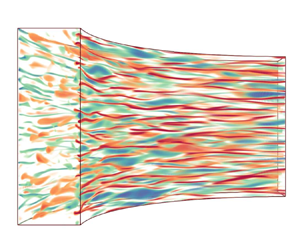Published online by Cambridge University Press: 27 November 2024

Turbulent flow induced by elastorotational instability in viscoelastic Taylor–Couette flow (TCF) with Keplerian rotation is analogous to a turbulent accretion disk destabilized by magnetorotational instability. We examine this novel viscoelastic Keplerian turbulence via direct numerical simulations (DNS) for the shear Reynolds number ( $Re$) ranging from
$Re$) ranging from  $10^2$ to
$10^2$ to  $10^4$. The observed characteristic flow structure consists of penetrating streamwise vortices with axial length scales much smaller than the gap width, distinct from the classic centrifugally induced Taylor vortices, which have axial lengths of the gap width. These intriguing vortices persist for the wide
$10^4$. The observed characteristic flow structure consists of penetrating streamwise vortices with axial length scales much smaller than the gap width, distinct from the classic centrifugally induced Taylor vortices, which have axial lengths of the gap width. These intriguing vortices persist for the wide  $Re$ range considered and give rise to intriguing scaling behaviour in key flow quantities. Specifically, the characteristic axial length of the penetrating vortices is shown to scale as
$Re$ range considered and give rise to intriguing scaling behaviour in key flow quantities. Specifically, the characteristic axial length of the penetrating vortices is shown to scale as  $Re^{-0.22}$; the angular momentum transport scales as
$Re^{-0.22}$; the angular momentum transport scales as  $Re^{0.42}$; the kinetic and elastic boundary-layer thicknesses based on angular velocity and hoop stress near the inner cylinder wall scale as
$Re^{0.42}$; the kinetic and elastic boundary-layer thicknesses based on angular velocity and hoop stress near the inner cylinder wall scale as  $Re^{-0.48}$ and
$Re^{-0.48}$ and  $Re^{-0.49}$, respectively. This implies that the viscoelastic Keplerian turbulence belongs to the classical turbulent regime of TCF with the Prandtl–Blasius-type boundary layer. Furthermore, we present an analytical relation between the viscous and elastic dissipation rates of kinetic energy and the angular momentum transport and in turn demonstrate its validity using our DNS data. This study has paved the way for future research to explore astrophysics-related Keplerian turbulence and angular momentum transport via the scaling relations of the analogous TCF of dilute polymeric solutions.
$Re^{-0.49}$, respectively. This implies that the viscoelastic Keplerian turbulence belongs to the classical turbulent regime of TCF with the Prandtl–Blasius-type boundary layer. Furthermore, we present an analytical relation between the viscous and elastic dissipation rates of kinetic energy and the angular momentum transport and in turn demonstrate its validity using our DNS data. This study has paved the way for future research to explore astrophysics-related Keplerian turbulence and angular momentum transport via the scaling relations of the analogous TCF of dilute polymeric solutions.
Present address: Max Planck Institute for Dynamics and Self-Organization, Göttingen 37077, Germany